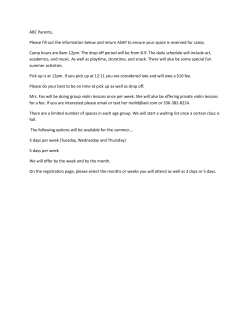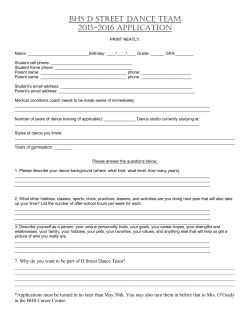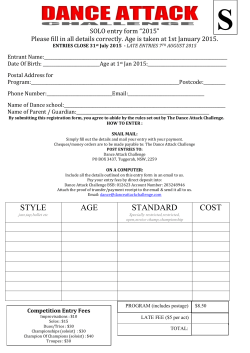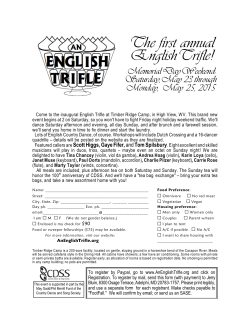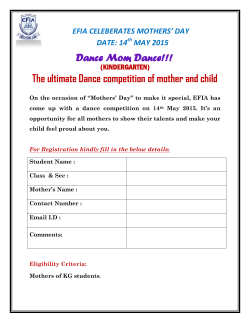
20/20 Goes to the Zoo
T. Clark Saunders, Acting Dean David Westfall, Director, Instrumental Studies Division Rita Porfiris, Chair, Performance 20/20 Chamber Music Janet Arms and Emlyn Ngai, Associate Chairs Ignacy Gaydamovich, graduate assistant 20/20 Goes to the Zoo Sunday, May 3, 2015 2:00 pm Animal Ditties VII for Brass Quintet & Narrator (1987) I. Duck I. The Praying Mantis III. The Cow IV. The Rhinoceros V. The Camel VI. The Octopus VII. The Squab VIII. The Firefly IX. The Wasp X. The Cukoo Berkman Recital Hall A. Plog (b. 1947) Grant Davis, Seth Bailey, trumpet; Laura Weiss, horn; Brian Johnston, trombone; Kayla Davis, tuba Scott Mendoker, coach Combo Platter, for alto saxophone, violin & marimba (1983) R. Aldridge I. Oneness, allness, togetherness…hold the mayo (b. 1954) II. For me there’s no more love/For you there’s no more pumpkin pie III. Wine, Women, and Geopolitical Realities Elyse Vest, saxophone; Kevin Seto, violin; Jianpeng Feng, percussion Ben Toth, coach Opus Number Zoo (1951, r. 1970) L. Berio (1925-2003) Shannon Vandzura, flute; Diego Vasquez, clarinet; Amy Mitchum, oboe; Emily Crompton, horn; Kristen Powell, bassoon Janet Arms, coach Intermission Duet for Two Cats G. Rossini (1792-1868) Arr. Robert Lucas de Pearsall Seth Bailey, trumpet; Brian Johnston, trombone; Cihan Yücel, piano Kevin Cobb, coach Carnival of the Animals (1886) I. Introduction and Royal March of the Lion II. Hens and Roosters III. Wild Asses: Swift Animals IV. Tortoises V. The Elephant VI. Kangaroos VII. Aquarium VIII. Personages with Long Ears IX. The Cuckoo in the Depths of the Woods X. Aviary XI. Pianists XII. Fossils XIII. The Swan XIV. Finale Camille Saint-Saëns (1835-1921) Cihan Yücel, Liana Paniyeva, piano; Shannon Vandzura, flute; Diego Vasquez, clarinet; Fernando Vizcayno, Kevin Seto, violin; Kaitlin Springer, viola; Ignacy Gaydamovich, cello; Kevin Huhn, double bass; Keyla Mejia-Garcia, guitar; Jianpeng Feng, percussion Edward Cumming, coach Program Notes Animal Ditties VII by Anthony Plog is a piece that has had many different versions published since its inception. Today's performance is arranged for brass quintet and was originally written for the American Brass Quintet in New York City. Only four voices of the quintet are performing at any one given time while the fifth member narrates dialogue written specifically for the piece. Each movement represents a different animal and the composer sought to write each movement in a style that represents those animals. - note by Grant Davis Robert Aldridge’s Combo Platter was written in 1983 for the duo, Marimolin. Violinist Sharan Leventhal and marimba player Nancy Zeltsman were joined by saxophonist Albert Regni to perform and record the composition. Marimolin premiered the piece in November of 1983 in Cambridge, Massachusetts. The first movement begins with all instruments playing a fast, groovy melody in unison. With a few exceptions, the marimba carries this groove throughout the entire movement while the violin and the alto saxophone alternate between playing lyrical melodic material and joining in on the groove with the marimba. Aldridge frequently changes meter and uses accents to give the movement forward momentum to the very end. The second movement starts off eerily and ghost-like. The marimba and violin start the movement very quietly, trading chromatic triplet figures. The saxophone enters on a large glissando followed by a lush, lyrical melody that is used throughout the entire movement. After this lyrical section, the marimba and saxophone play figures in rhythmic unison that are reminiscent of the fast, 16th note passages from the first movement. Then, unexpectedly, the trio enters a tango together, using the same notes from the first melody introduced by the saxophone at the beginning of the movement. This dance takes us to the end of the second movement, but not before a reference is made to the first movement in the very last measure. The third movement is similar to the first, with constantly changing meters and accents throughout to propel the music forward. This movement is the most rhythmically complex of the three. The violin and saxophone are often in rhythmic unison or are exactly a beat off from one another while the marimba keeps the tempo going with near perpetual motion. Repetition is also used throughout the movement accompanied with accents to create a groove similar to the first movement. The tempo marking at the beginning indicates “playful and eccentric,” which is an accurate depiction of the mood of the entire movement. Movement titles were later added to the piece when the work was performed at the Brevard Music Center in 2012 by violinist Jason Posnock, marimba player Gwendolyn Burgett, and saxophonist Joseph Lulloff. The movement titles are as follows: I. oneness, allness, togetherness, hold the mayo II. for me there's no more love, for you there's no more pumpkin pie III. wind, women and geopolitical realities -note by Elyse Vest Opus Number Zoo was composed by Luciano Berio in 1951 for the instrumentation of two clarinets, two horns and speaker. He later revised it in 1970 for wind quintet with text integrated into each part, to be premiered by the Dorian Quintet. Unlike most of Berio's works which are highly atonal and serial, Opus Number Zoo adapts a more neo-Classical approach. This piece shows a more light, humored side of Berio in composition. The libretto narrated by the musicians themselves, was written by Rhoda Levine. Levine was an American director and choreographer, involving herself heavily in works of a political nature. Levine's allusion to war is subtly disguised in the lightness of animal characters. Levine's libretto in combination with Berio's ingenious instrumental writing, that so accurately illustrates and supports the text, makes for a thought-provoking and enjoyable performance. Barn Dance The fox took a chicken out on the floor. Poor silly chick didn’t know the score. And as they whirled in their joyous dance Oh, she admired how the fox could prance. She never noticed when the light went out. She skipped to the beat with head held high, She bowed to the fox as he circled by. He winked at her with a high-dee-hoe, And they then engaged in a doesee doe. She never noticed when the lights went out. He swung her to the left, He swung her to the right, He swung her around with all his might. The air grew heavy, the lights grew dim But she felt no fear as she smiled at him; He turned her again and she held him tight As she smiled and whirled in the fading light, She felt no fear, she knew no doubt And she never noticed when the light went out. That’s all folks. The Fawn Listening to a cry of bombs, Listening, to the scream of a distant field, Listening, this is what the fawn thought, standing by a steam. What madness, what madness of men To diminish the earth, To blast all that is lively, Lively proud and gentle. What can be the reason? The fawn thought, Listening to a cry of bombs, Standing by a stream. What can be the reason? The Grey Mouse By herself, by herself, Watching the party, This small mouse upon a shelf. Very old, very old, She felt no cheer at the dawn of the New Year. Friends, she said, young friends, she said, Dance, my young friends, dance, but do beware, I warn you! For I too have dance and sung like you I too have been young so young but alas Time came to join in the dancing, Came to join in the fun. Tom Cats In the jungle of the city Two tom-cats chanced to meet. Omar and Bartholomew, Tip-toeing round their beat. Their chest swelled up with envy (oh, an envy most intense) As each spotted his new rival, Beside a back-yard fence. Bartholomew’s great tail (a tail of wide renown) Made Omar stare insanely, That tail he’d love to own. Bartholomew stared also, He envied what he saw. He yearned to own the whiskers That Omar proudly wore. A howl soon broke the silence Of that mid-summer night. Like David and Goliath, Both cast aside all fright As cat met cat in battle. It was a beastly fight. Both limped home forlorn. All tail all whiskers gone. -note by Shannon Vandzura Carnival of the Animals is Saint-Saëns’ best-known work. He told his publisher that it is so much fun to write it that he has to postpone his work on his third symphony. The piece became very popular among his friends and was not publicly performed until after his death, in 1922. The only part that he allowed to be published during his lifetime was the famous Swan movement, which he arranged for one piano and cello. The piece is often performed with a narrator reading witty poems written by Ogden Nash in 1949. -note by Ignacy Gaydamovich
© Copyright 2025


